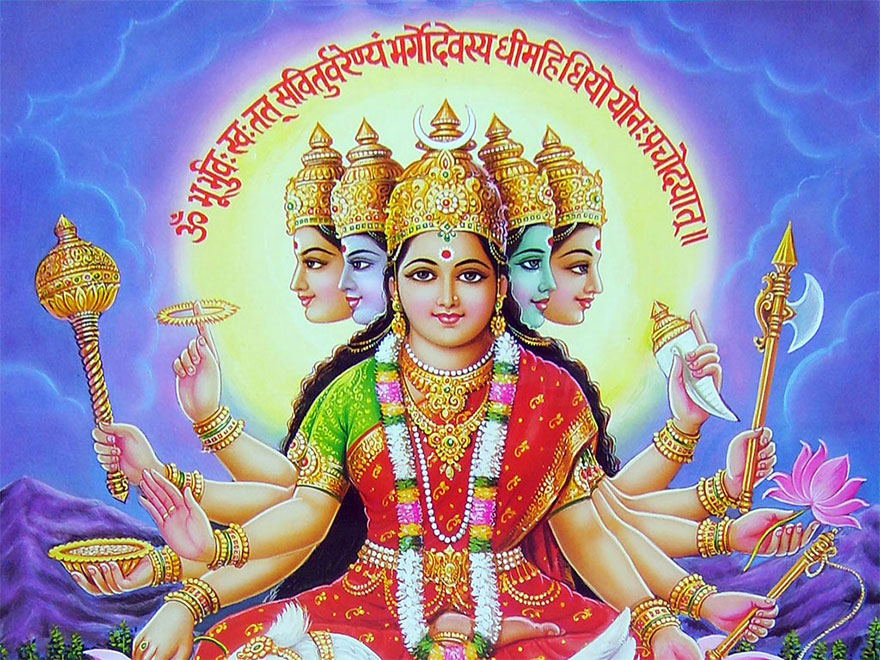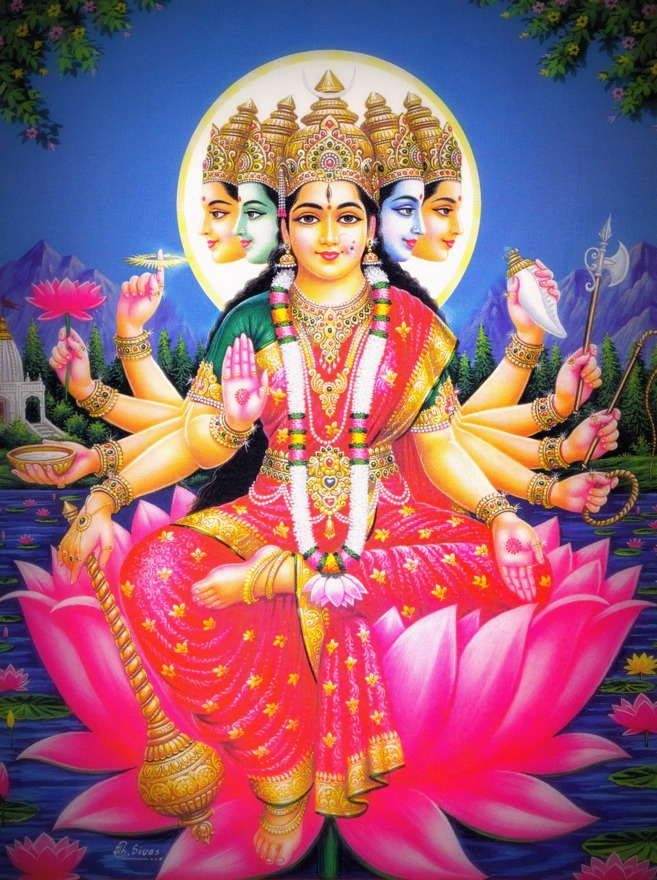The Gayatri mantra is a 6,000-year-old verse recited by millions of Hindus every day all over the world. This mantra – Rigveda Samhita 3.62.10 – was composed by sage Vishwamitra. He composed most of the poems in the third section of the Rigveda.
This verse is called the Gayatri mantra possibly because it is composed in the poetic meter called Gayatri. A verse written in this poetic meter should have three lines and each line must have eight syllables. It is interesting to note that the etymology of the word Gayatri is gāyantaṃ trāyate iti gāyatrī, “Gayatri is that which protects the person who recites it.”
Therefore, although there are thousands of verses composed in the Gayatri metre, when we say Gayatri mantra, it specifically denotes this verse:
tat saviturvareṇyam |
bhargo devasya dhīmahi |
dhiyo yo naḥ pracodayāt ||
In Sanskrit, every word has several meanings. So it’s important for us to understand the context in which a certain word is used. Let us take a look at what each word in this mantra means:
tat = that
savituḥ = the sun; literalley “one who permits”, “one who stimulates”, “one who vivifies”
vareṇyam = best, excellent, worthy of the highest respect
bhargaḥ = light, lustre, radiance
devasya = of god, of the lord, of the deity
dhīmahi = (we) meditate, contemplate
dhiyaḥ = intellect, wisdom, mind, consciousness
yaḥ = the one who, he who
naḥ = to us, for us
pracodayāt = (one who) inspires, motivates, stimulates, empowers
[wp_ad_camp_1]
(An astute observer will find that the first line has only seven syllables instead of eight: tat-sa-vi-tu-rva-re-ṇyam; therefore while recitation, we add the syllable om in the beginning or we say tat-sa-vi-tu-rva-re-ṇi-yam).
Let us try to arrange this in the form of a sentence. One who (yaḥ) stimulates (pracodayāt) our (naḥ) mind (dhiyaḥ) – we meditate (dhīmahi) on that (tat) excellent (vareṇyaṃ) radiance (bhargaḥ) of the lord (devasya), the sun (savituḥ).
A simple English translation would give us:
We meditate on
the wonderful radiance of the sun god,
who stimulates our mind.
The same Gayatri mantra also appears in the Yajurveda but with an additional line in the beginning:
oṃ bhūrbhuvassuvaḥ |
om = the single-syllable word that represents brahman, the Supreme Being
bhūḥ = earth
bhuvaḥ = atmosphere
suvaḥ = sky, heaven
With this line, we bring our awareness to the three spheres of existence, thus connecting with something bigger than our tiny selves.
In the Hindu tradition, we believe that there is only one Supreme Being (brahman) but there are several gods. These gods may be realized in any form.
The forces of nature – wind, lightning, thunder, fire – are deified. The animate and inanimate beings – animals, plants, rivers, mountains – are deified. The celestial objects – sun, moon, planets, stars – are deified. We may also see god in a sculpture, a painting, or even in a song.
Among all these various possibilities, the sun is the most magnificent. Of course, an astrophysicist might tell us that the sun in our solar system is a veritable pygmy in front of some of the other stars in the universe. Even so, the sun remains the most brilliant object we can see with our naked eyes. Not only do we see it but we also feel its presence. It removes darkness and brings light. It removes the cold and brings warmth. The radiance of the Supreme represents Knowledge (which removes the darkness of ignorance) and Vitality (which removes the coldness of lethargy).
So the Gayatri mantra is a prayer to the Supreme, in the form of the sun, which stimulates our mind and empowers us. Just like the sun wakes us up every morning, we pray that the Supreme light wakes up our intellect. It is indeed a prayer for internal strength.
In the 1990s cartoon series Captain Planet, there is a beautiful symbolism for this – whenever Captain Planet is on the verge of defeat, he draws energy from the sun. He gets revitalized. He’s ready to face his enemies – those trying to pollute the earth. The Gayatri mantra does something similar, but within.















Thank you for sharing this wonderful information..
Gayatri Mantra- what a lovely meaning and simple one though. Thanks for sharing this.
Thanks for the simple, straight forward and a very useful explanation of the most important mantra of all – the Gayathri Mantra. It is customary to add the first line “Om Bhu Buvar Suvahah” which means the “One who is common to our wakefulness, dreaming and sleeping states”. This sentence is the essence Brahman – as we perceive it in our body, mind and intellect.
A great and very simple explanation on this perception of Brahman is given by Adi Sankara in his wonderful book called ‘Atma Bodham”.
Well, for making Brahman as a perceptible one to be realised in one’s own self, the King Viswan got his tribute as a Vishwa’Mitra’ – meaning friend of the learned people.
May be you can expound this line also a bit more and publish an explanation of ‘self’ as given in ‘Atma Bodham’.
Best Wishes to Indiadiving.org, for really explaining why India is the place of the Diving on this “Holy” Planet.
Best Regards
Renga Iyengar
The Mantra which gives power
The meaning of Gyatri Mantra has been given so beautifully. Thanks ever so much. Since I can remember I have recited the mantra numerous times in the day. I know The Reciting of the mantra has made me into what I am, God has taken care of me and mine.and everyone round me.
Pranam
The compose of Gayatri Mantra is incomplete when took as per Rig Veda. It has to be combined the Yajur Veda’s addition and that becomes the complete Mantra. One can surrender with this complete Mantra to the Supreme Universal Power and by this merging the Tri Qualities of own to become Jintendriya Maharshi.
Gayatri Mantra does NOT have an age. It is time immemorial. It is wrong to say it is 6000yrs old. That is a very western concept.
Sage Vishwamitra did NOT compose Gayatri Mantra. He is the “Mantra Drashta”. He perceived/saw what was already there.
it is very much useful for the ignorant people of the world.
Very informative.
I have also read that when chanted with proper pronunciation and voice modulation , Gayatri mantra creates vibration in the body which keeps us fit
ॐ भूर्भुवः स्वः
तत्सवितुर्वरेण्यं ।
भर्गो देवस्य धीमहि
धियो यो नः प्रचोदयात् ॥
Thanks for clear explanation and simple rendition of Gayatri Mantra, for everyone to grasp the profound reality of universal power.
I have started reciting the Mantra 1008 times in the morning.It takes maximum an hour and I suggest all to devote this time to start with on weekend days
Given explanation is very enlightening. One must get it initiated by an expert for clear pronunciation. Must practice methodically, regularly and with belief. Gayatri Mantra is clubbed in prayers to other deities also. Ex: Ganesh Gayatri, Lakshmi Gayatri etc., for an effective result. These are also must be initiated by experts. After meditation for some counts a fire rituals like Gayatri Homam gives very good results. This is also to be known and practiced through an expert. Prof.C.S.Rao
Excellent.
Excellent
Very informative and useful article on the powerful gayatri mantra.
Gayatri was not ‘composed’ but seen by Seer Vishvamitra. None of the Suktas are composed they were seen. Therefore the Rishis are known as mantradrishta
The meaning of Gaythri Mantra explained so beautifully. thank you so much
The meaning is actually this: ‘We meditate on that supreme radiance of the Sun God who stimulates our intellect’. This Sun is not the sun we see in the sky who sustains the physical existence; on the other hand, He is the One who stimulates the intellect. He is the Sun whose radiance is pure consciousness; He is Atman. He lives through all the states of consciousness and all the times viz. the past, present and future. He is the composite OM.
savituh means ‘of savitR’ (of the sun). It is in genitive case.
Hi ,
Its a Gift of GOD for all human being ,The Gaythri Mantra always make me from strong to strongest . Thanks.
It is very much useful for the ignorant people of the world.
Very nicely explained with inner meaning.
Thanks for your information.
Sage vishwamitra did not compose the Gayatrimantra,as many believe. Gayatri is not a woman as many believe.yet she is depicted as a woman with FIVE FACES.
The Mantra existed,even before sage vishwamitra was BORN . He only uttered this MANTRA from Rigveda & the god said from now onwards,what you uttered will be known as “Gayatri Mantra”
As mentioned ,in sanskrit a WORD has several Meanings & depending on the context,one has to draw out a meaning,that suit him,or liked by him> The mantra actually refers to SuryaBhagawan(It is clear in ADITYA HRIDAYA)He is all in all & is everything,He is the trinity etc.
I agree that the Gayatri Mantra is more than 6000 years old. Sage Vishwamitra is the originator and as we know he was a contemporary of Rama. Rama lived about 20,000 years ago according to Bhagwan Sathya Sai Baba…
I request you to also look into the long form of the Gayatri, which begins: Om bhoo, Om bhuvah, Om suvah, Om mahaha, Om Janaha, Om tapaha, etc.
Thank you for sharing ✨???
1. All Vedic manthras are sabdas, ever existing in sound form, like the electro magnetic waves (eg. tv vaves), in the space. The wise sages tuned their mind / intellect in tapasya accessed the manthra. and with conviction passed it on to humanity out of kindness without expecting reward.
2. It is the uchharana, sound which is the form of the manthra, not the lipi in which it is written and therefore the correct delivery of the sound is regarded as important.
3. Gayathri is a metre, consisting of 24 sound-characters. This manthra is known as Savithri manthra. As nya is treated as one in japam, the japam is known as in 23 sound-charecters, nichat gayathri meter. For some purposes, in argyam etc, n-ya should be stated separately. There are rules for it and therefore all these manthras are to be learnt from a proper guru. In sama ganam ni-yom is separately stated and sung.
4. While for the student of the initial stages, it is the visible sun who is pointed out for addressing, as one progress in stages, the Upanishads refer the swayam prakasa ATMAN in the hridaya-akasa as the goal for realization.
5. Thanks for bringing this for discussion. Best wishes to all participants.
I had the impression that Gayatri Mantra is for Goddess Durga.
Thanks for the explanation. But I did not understand the reason for 3 women face for Gayatri.
Please share if anyone knows.
Thanks
A simple and apt meaning has been given .Excellent work.
Thanks a lot .
Also, as mentioned by many , this mantra was not composed by sage Vishwamitra. For that matter no mantra was composed by any Rishi. When they were in the seat of meditation these mantras were revealed to them and they were pervading here and there. Vyasa Maharishi collected them all and compiled them in Vedas.
Each devatha has a manthra in gayathri meter. The subject under discussion is the generally known Savithri manthra in gayathri meter…”om thath ………..prachodayat”, which is mother of all manthras, realized and propounded by the great sage Viswamitra. All manthras have rupa for meditation. This manthra of supreme Sakthi is contemplated in the benevolent form of the Supreme mothers Sri Durga, Lakshmi and Saraswathi – gunas identified with the morning, noon and evening. Brahma, Vishnu, Siva are behind the devi forms. And beyond them the Supreme un-manifested Brahman. Bestowing of this manthra by the Guru to the shishya during “upa-nayana” is known as “brahmopadesa”. Thus when one meditates with Gayathri manthra it is to realize the Supreme Brahman (paramathman). A Realised person sees the Self in everything.
Ok. The Gayatri Mantra is eternal.The Spiritual nature is eternal . The Supreme Lord,Krsna, is eternal and we,the souls(parts and parcels of the Supreme) are eternal too.We are not this physical body. We can see that everything emanates from The Supreme Personality of Godhead Sri Krsna. Isvarah Paramah Krsna ..sat cit ananda vigrahah.Anadir adi Govindah sarva Kara Karanam.The material nature is also eternal ,but the manifestation is temporary ” Sarvam Khall idam Brhaman”
Dear Author, Thank you for the wonderful article. However please note that nobody composed Savitar Mantra (Gayathri Mantra) Also the verses in Rig , Yajur, etc are called Hyms or Samhithe, they are not poems.
In Kalyuga we use the Mudras given by Bramha-Rishi VishwaMithra, when performing nithya Karma.
Mudras are not necessarily any sort of physical adornment, rather Mudras are Mantras that we chant whilst getting the environment and our bodies to be in a state to chant the Samhithe (Savitar Mantra)
Eg:Pranavasya, Vishwa Mitra Rishihi, Devi Gayathri chandaha, Paramathma Savita Devatha.
In the above, it is clear that the above mantra was given by Rishi VishwaMitra. Also please note that Vedic Mantras are not composed, rather it is revealed by supreme Brahman.
Excellent. I daily recites this mantra with my family which gives us great pleasure. I am greatfull to all translating this great mantra in simple form.
Gayatri Mantra should not be recited loudly – it is of no use.
If recited with lip movement and without sound then the effect is partial. It should be recited inside the heart (soul). Also, it should not be recited as a text in single sentence, as
oṃ bhūrbhuvassuvaḥ tat saviturvareṇyam bhargo devasya dhīmahi dhiyo yo naḥ pracodayāt
It should be recited in five words as follows with a time gap between the words.
oṃ
bhūrbhuvassuvaḥ
tat saviturvareṇyam
bhargo devasya dhīmahi
dhiyo yo naḥ pracodayāt
If done this way one will get the full benefit of the Mantra.
Wonderfull explanation of Gayarthri mantra to understand the hidden meanig of Mantra.
As long as we read the article the mind will be in a state of stillness and awaken the self.
I found my mind lake is still and free from ripples.
Thaks to the author of this article
fine i have been reading these explanations for a long time but can you please do some thing – the description of Gayatri mata- mukta vidru mahema with this description of the mother i have never seen a pic kindly post such a picture which matches the description all those pics available in google does not match hope some body can give me what i desire so that we can tell the next generation the description matches with the pic